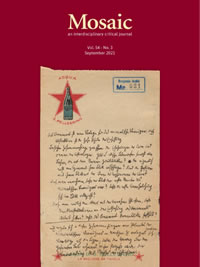Issue 54.3
Overview

Special Issue: Featuring: Frédéric Neyrat
Published: September 2021
View the issue introduction or see the issue summary and contents below.
8 essays, totalling 180 pages
$24.95 CAD
Mosaic issue 54.3 is a special author issue featuring the work of Frédéric Neyrat and including essays by Naomi Mandell, Sue Lovell, Gi Taek Ryoo, and Andrew Haas. Alongside two essays by Neyrat, you will find an interview focussing on the philosopher’s book, The Unconstructable Earth (2019), and you will encounter Arne De Boever’s introduction to Neyrat’s wider project via what he describes as “philosophy’s ins—and especially its outs.”
On Frédéric Neyrat’s Critical ThoughtArne De Boever Abstract unavailable at this time. | |
Crossings: A Conversation with Frédéric NeyratFrédéric Neyrat and Shepherd Steiner The following interview with Frédéric Neyrat was conducted electronically in 2020. Mosaic is pleased to publish the interview here. | |
Heliopolitics (Or How to Cure an Amnesiac Sun?)Frédéric Neyrat After the end of the grand narrative of coal (associated with the working class and collective struggles), and then the end of the grand narrative of oil (which fueled individualistic dreams), this essay instigates a solar grand narrative from which to rethink the relation between ecology, technology, and politics: the Heliopolis to come will be an unstable dwelling, a civic bivouac spinning endlessly, sailing across an expanding universe. | |
Walter Benjamin’s Cosmos: Correspondence, Aura, and the Cosmo-Geological SubjectFrédéric Neyrat In the interpretation of Walter Benjamin’s philosophy, his thinking is commonly divided into two distinct blocks: the culture-language-aesthetics block, where language functions as a mediation between the critique of culture and the analysis of technology at work in art, and the politics-history-theology block, where history mediates between Benjamin’s (quasi-)Marxist politics and his heterodox messianism. I propose to question this conventional interpretation by exploring Benjamin’s cosmology, his thinking of the universe and the Earth, the way this thinking determines the concept of aura, and the new type of subjectivity that this philosophy induces. Benjamin’s cosmos is neither an ordered and hierarchical space, nor a totality of celestial objects, but rather the occasion of a lightning experience, an improbable “constellation” where the most distant in space and time fleetingly encounter the here and now. | |
‘To float, to hide, to disappear’: The Hacker in The CircleNaomi Mandel Reading Dave Eggers’s The Circle through the figure of the computer hacker, this essay reflects on the history of hacking, hacking’s evolving relationship with embodiment, and the implications of this relationship for the representation of technology in literature. | |
T.C. Boyle’s A Friend of the Earth and the Posthumanization of ReadersSue Lovell This essay analyses how T.C. Boyle’s A Friend of the Earth represents an embodied character embedded in material and social environments (zoe-life) processing trauma using Braidotti’s affirmative ethics. It argues that readers experience a loss of individual agency instrumental to becoming posthuman. It connects current discussions on climate change and Anthropocene thinking to critical posthumanism in relation to shifting readers’ subjectivities. | |
The Systemic Nature of Environmental Disaster: Muriel Rukeyser’s The Book of the DeadGi Taek Ryoo With scientific insights drawn from systems theory, this essay examines Muriel Rukeyser’s The Book of the Dead, which addresses the Hawk’s Nest Tunnel disaster, illuminating how the poem embodies the systemic nature of environmental disaster that emerges through the interactions of nature and matter, culture and technology, and human and nonhuman. | |
Hegel’s Philosophy of the WorldAndrew Haas Hegel’s Philosophy of Right is not a philosophy of the state—it is a philosophy of the world. This means that right must be rethought—for it is neither present in the world nor absent therefrom, but implied thereby, which is how right is right, and rights right. |